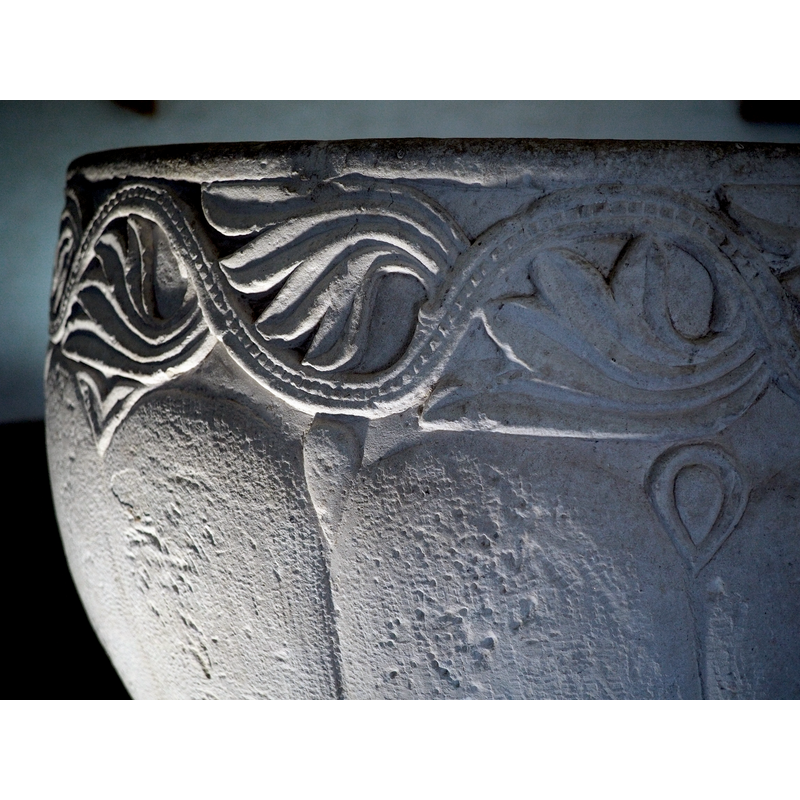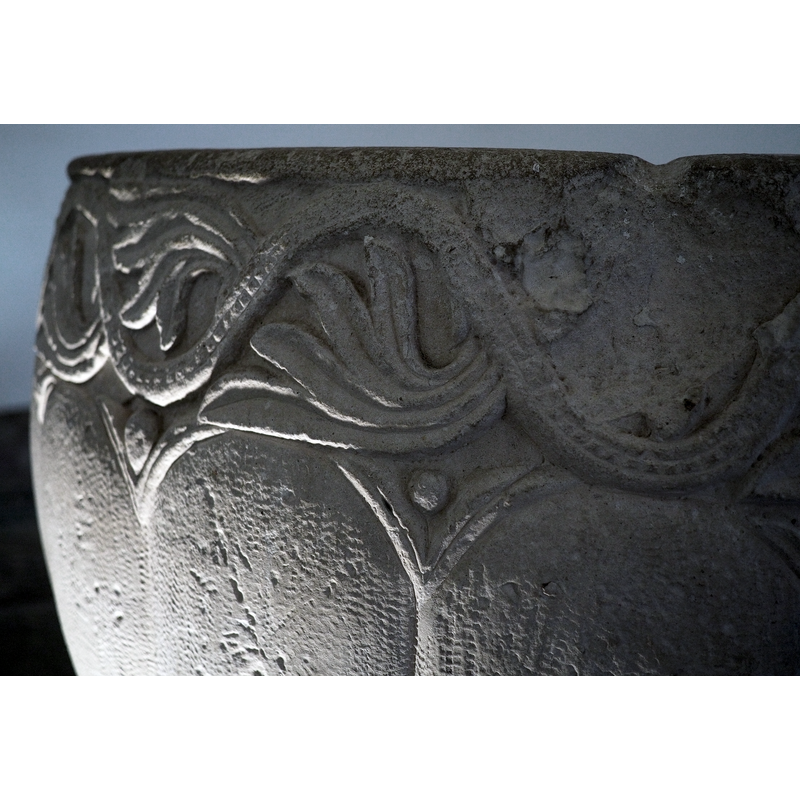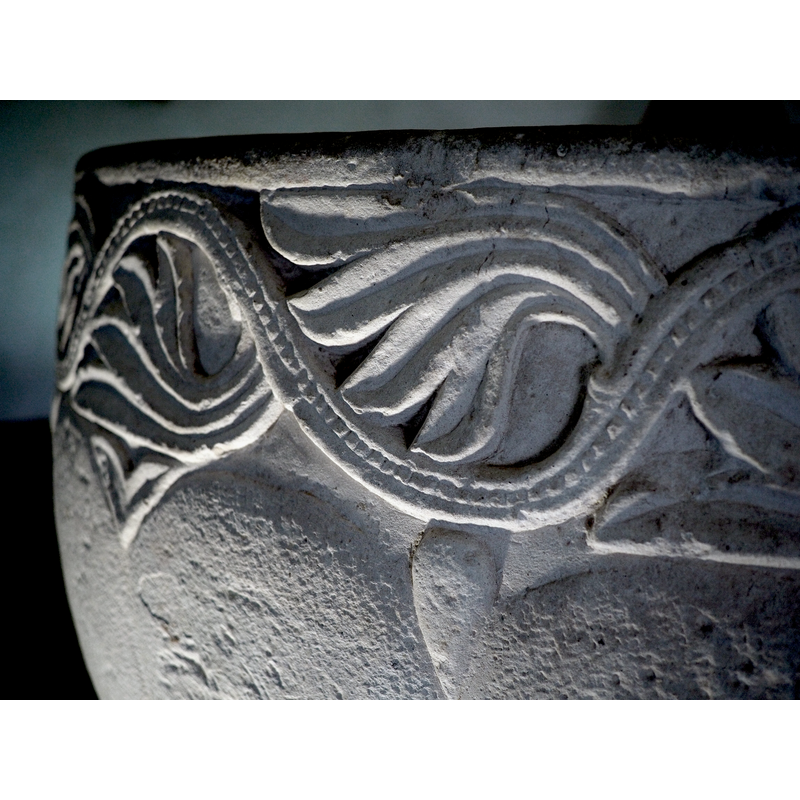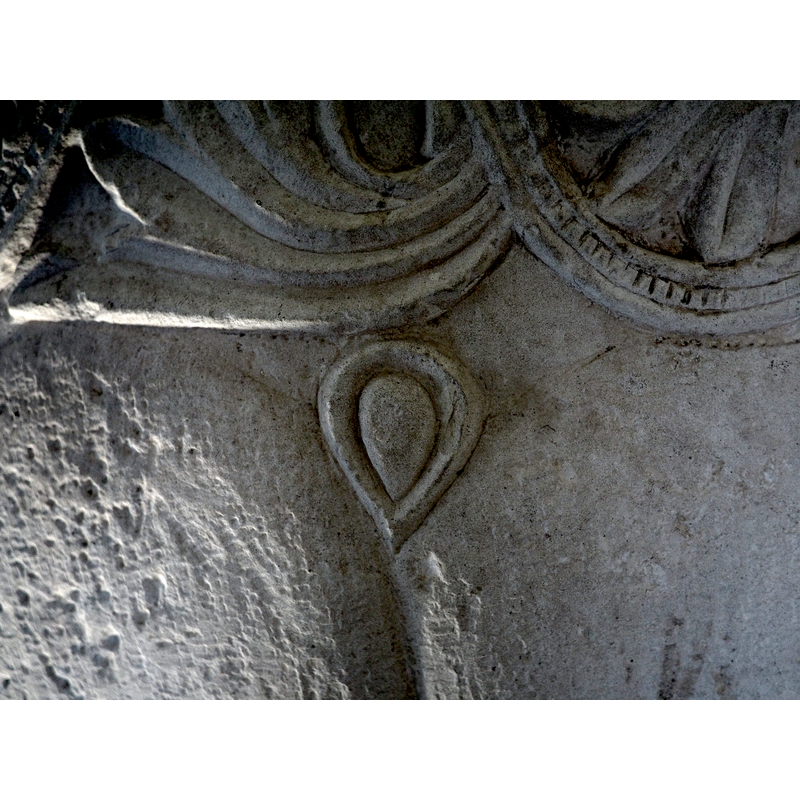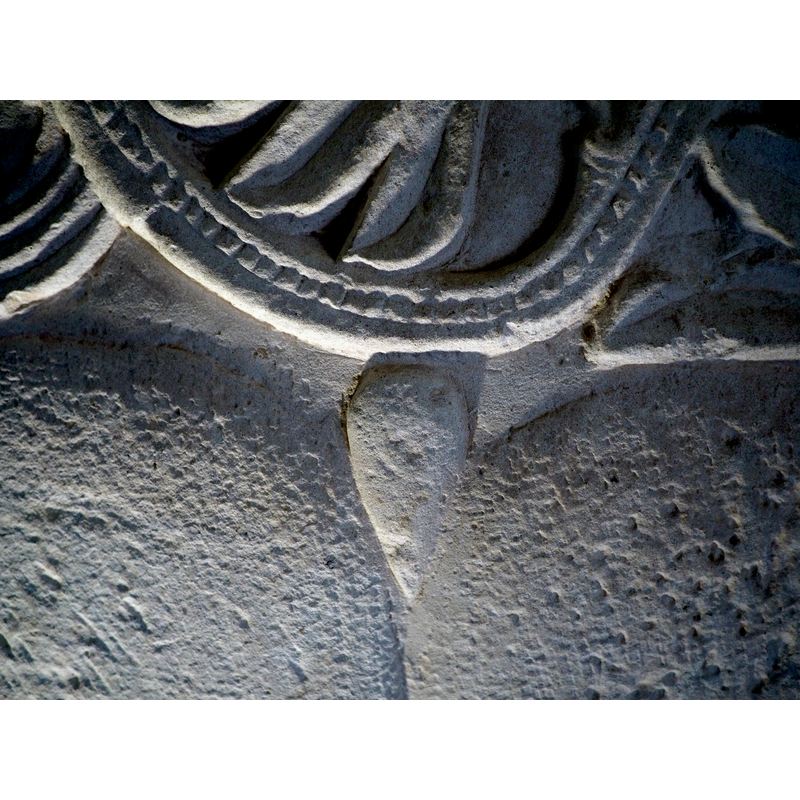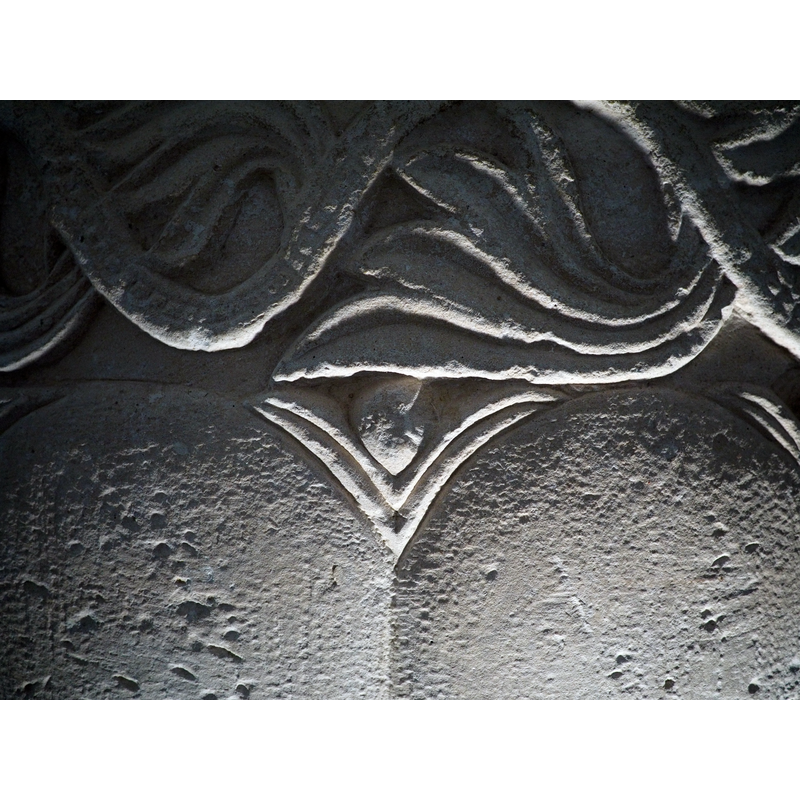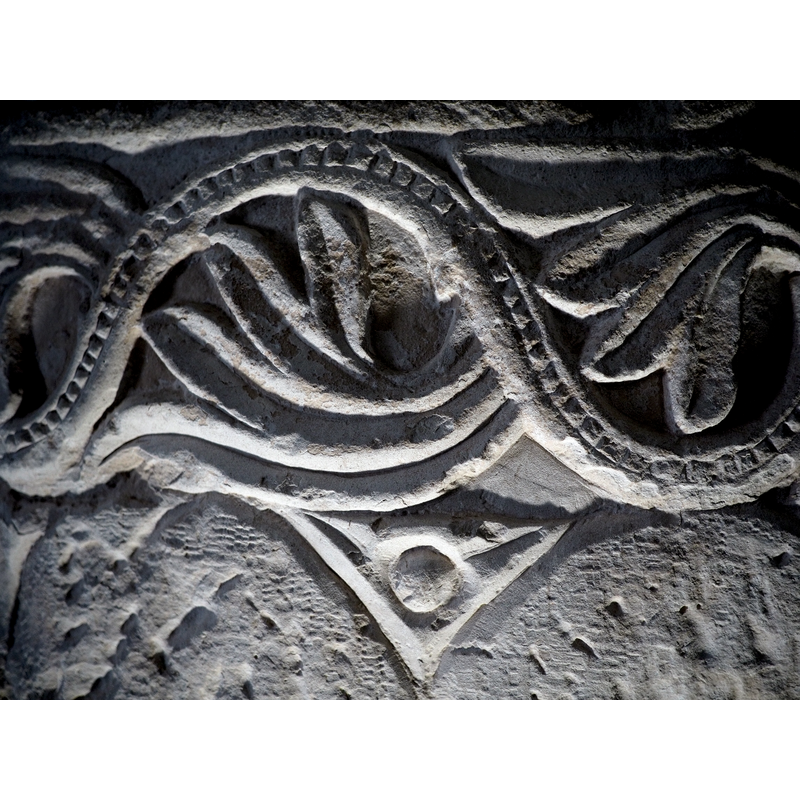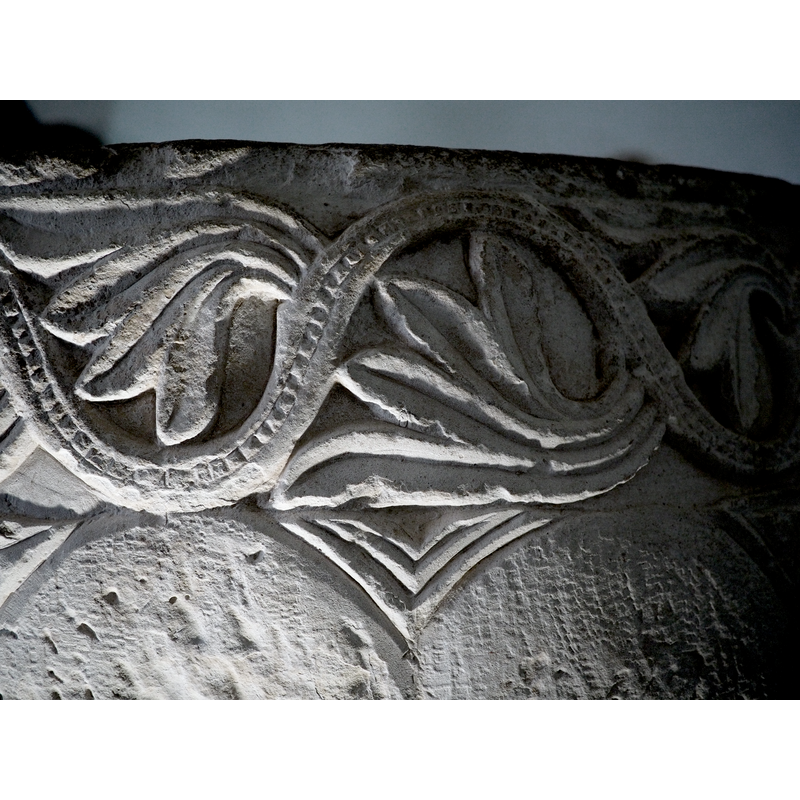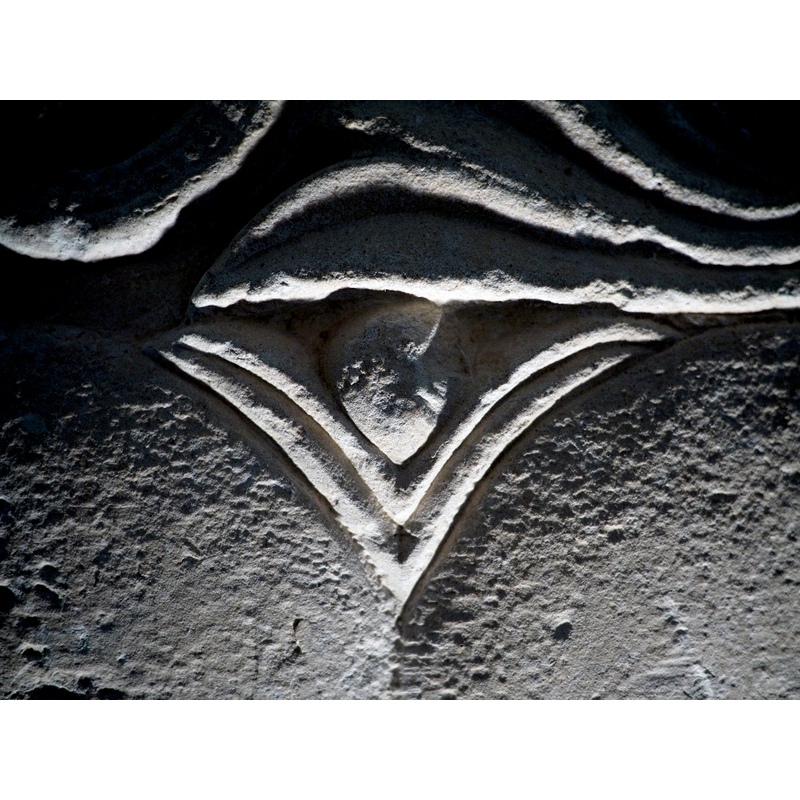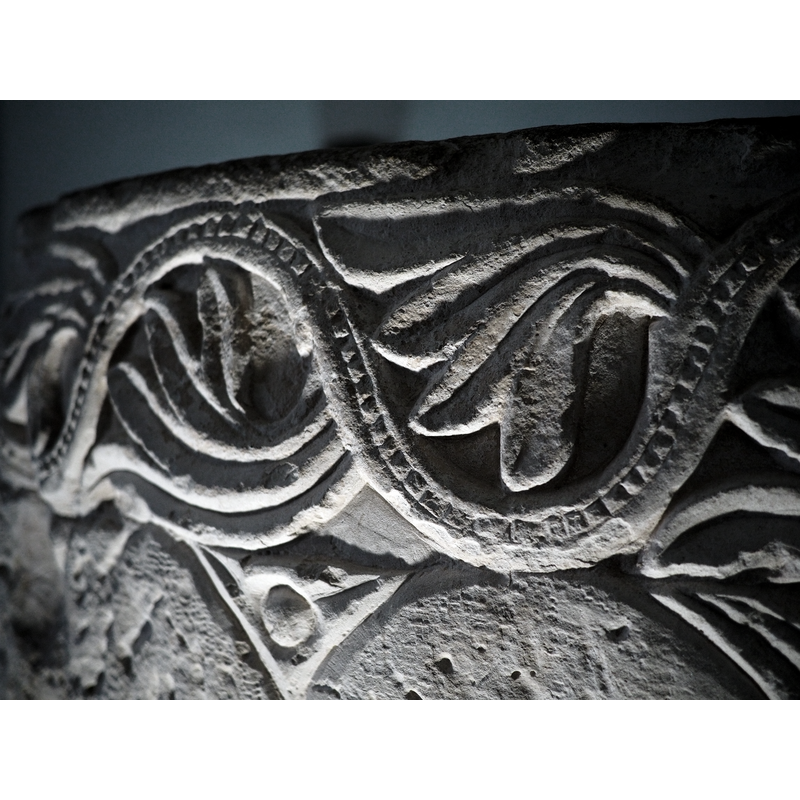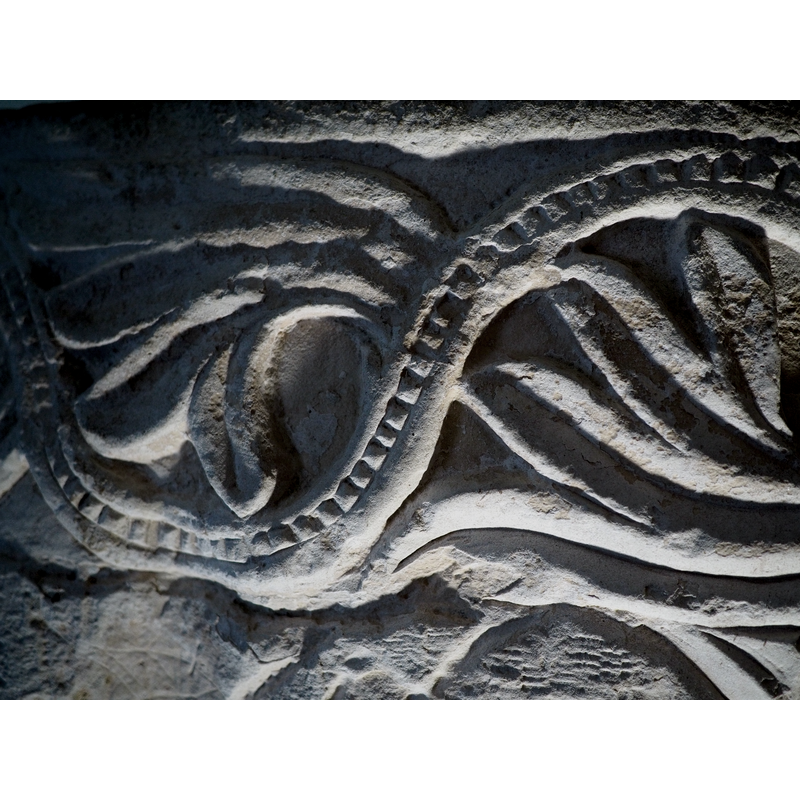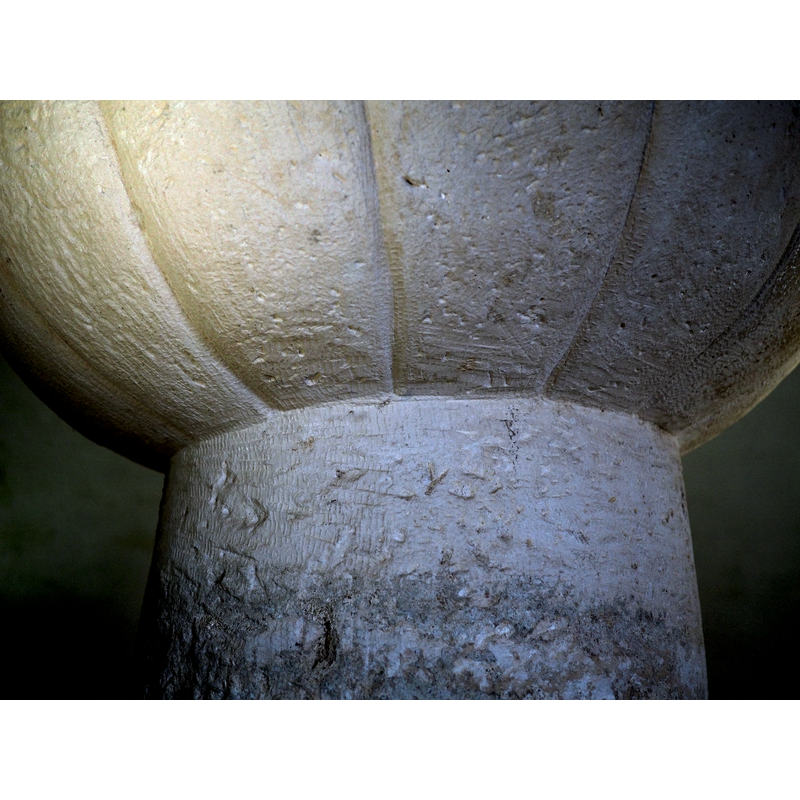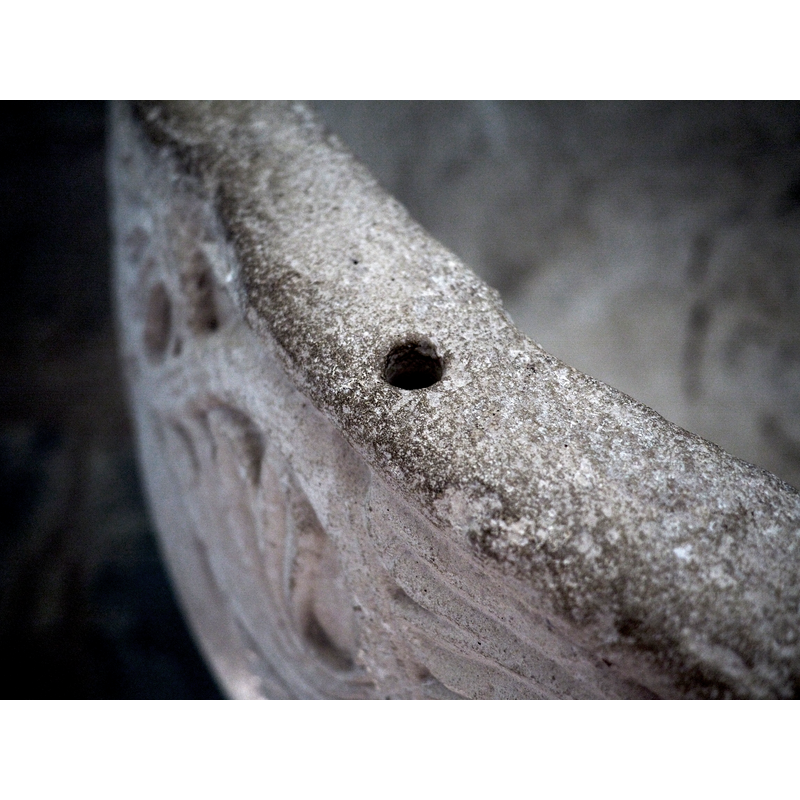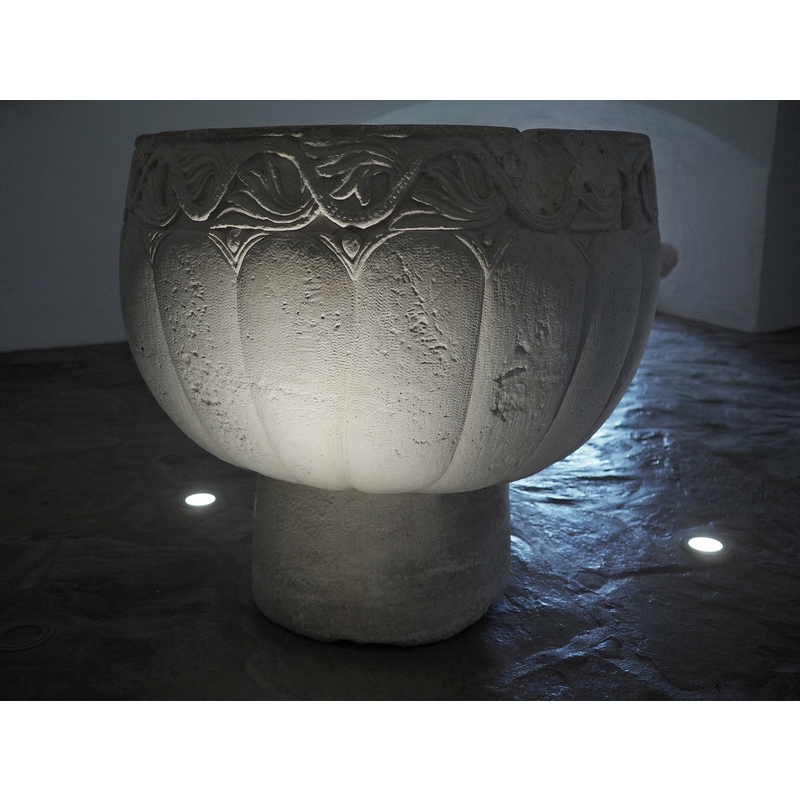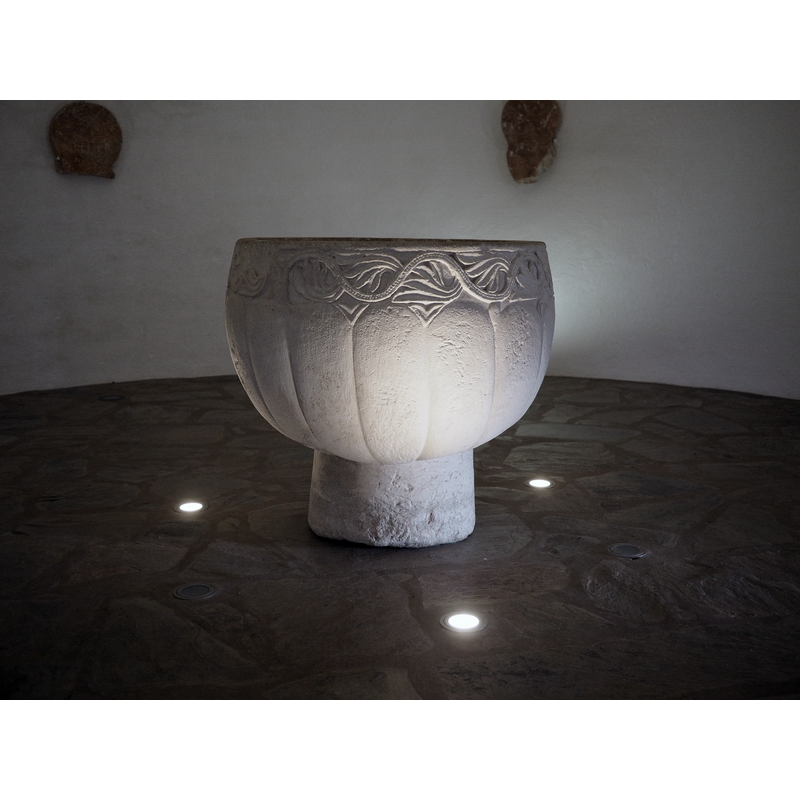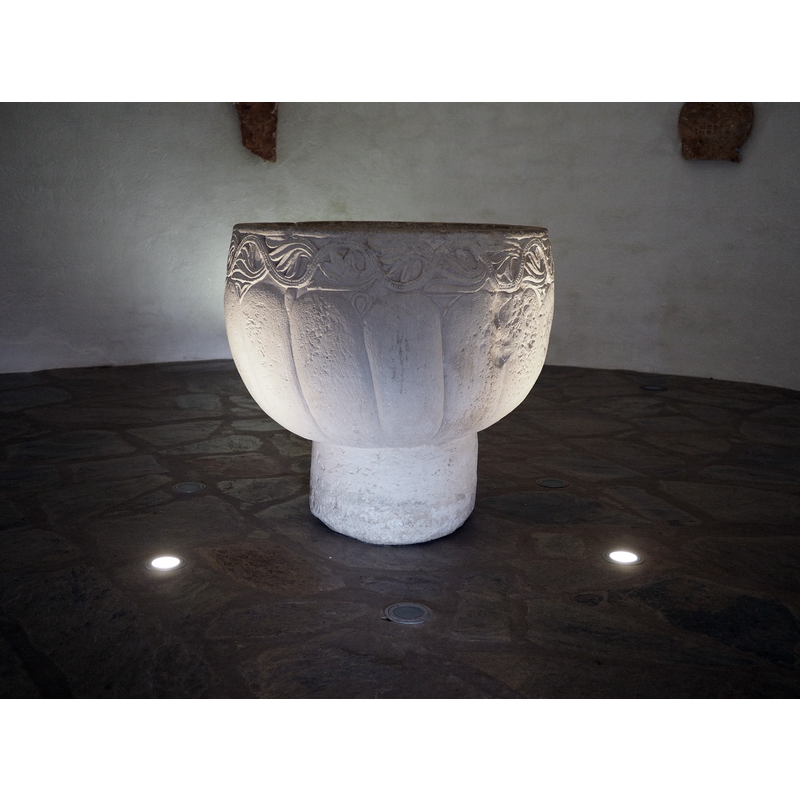Alcobaca No. 1 / Alcobaça
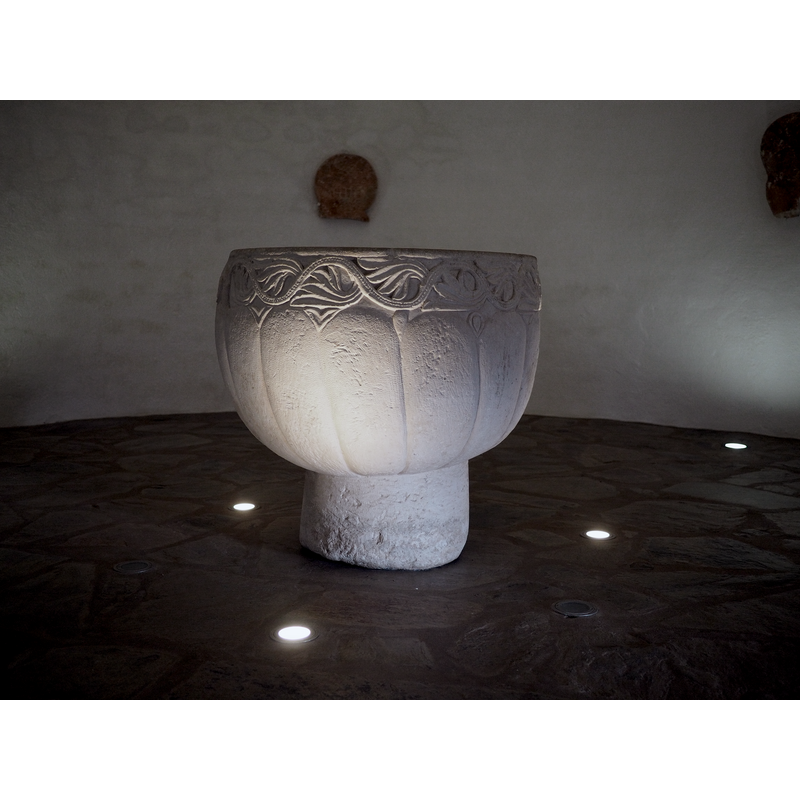
Image copyright © Joost Limburg, 2016
Standing permission
Results: 28 records
animal - mammal - quadruped - head - vegetation stemming from its mouth
Scene Description: the semi-hidden animal head has canine features and very prominent sharp teeth; two beaded tapes issue from between its jaws and form a stylised acanthus vine that wraps all around the upper side of the basin
Copyright Statement: Image copyright © Joost Limburg, 2016
Image Source: digital photograph taken 16 October 2016 by Joost Limburg
Copyright Instructions: Standing permission
animal - mammal - quadruped - head - vegetation stemming from its mouth
Scene Description: the semi-hidden animal head has canine features and very prominent sharp teeth; two beaded tapes issue from between its jaws and form a stylised acanthus vine that wraps all around the upper side of the basin
Copyright Statement: Image copyright © Joost Limburg, 2016
Image Source: digital photograph taken 16 October 2016 by Joost Limburg
Copyright Instructions: Standing permission
animal - mammal - quadruped - head - vegetation stemming from its mouth
Scene Description: the semi-hidden animal head has canine features and very prominent sharp teeth; two beaded tapes issue from between its jaws and form a stylised acanthus vine that wraps all around the upper side of the basin [NB: the detailed of the head is shown here rotated 90 degrees clockwise]
Copyright Statement: Image copyright © Joost Limburg, 2016
Image Source: digital photograph taken 16 October 2016 by Joost Limburg
Copyright Instructions: Standing permission
design element - motifs - floral or foliage
Scene Description: each of the spandrels created at the top of the ribbed pattern, just below the band of acanthus vine, is decorated with lovely stylised motif, all different
Copyright Statement: Image copyright © Joost Limburg, 2016
Image Source: digital photograph taken 16 October 2016 by Joost Limburg
Copyright Instructions: Standing permission
design element - motifs - floral or foliage
Scene Description: each of the spandrels created at the top of the ribbed pattern, just below the band of acanthus vine, is decorated with lovely stylised motif, all different
Copyright Statement: Image copyright © Joost Limburg, 2016
Image Source: digital photograph taken 16 October 2016 by Joost Limburg
Copyright Instructions: Standing permission
design element - motifs - floral or foliage
Scene Description: each of the spandrels created at the top of the ribbed pattern, just below the band of acanthus vine, is decorated with lovely stylised motif, all different
Copyright Statement: Image copyright © Joost Limburg, 2016
Image Source: digital photograph taken 16 October 2016 by Joost Limburg
Copyright Instructions: Standing permission
design element - motifs - floral or foliage
Scene Description: each of the spandrels created at the top of the ribbed pattern, just below the band of acanthus vine, is decorated with lovely stylised motif, all different
Copyright Statement: Image copyright © Joost Limburg, 2016
Image Source: digital photograph taken 16 October 2016 by Joost Limburg
Copyright Instructions: Standing permission
design element - motifs - floral or foliage
Scene Description: each of the spandrels created at the top of the ribbed pattern, just below the band of acanthus vine, is decorated with lovely stylised motif, all different
Copyright Statement: Image copyright © Joost Limburg, 2016
Image Source: digital photograph taken 16 October 2016 by Joost Limburg
Copyright Instructions: Standing permission
design element - motifs - floral or foliage
Scene Description: each of the spandrels created at the top of the ribbed pattern, just below the band of acanthus vine, is decorated with lovely stylised motif, all different
Copyright Statement: Image copyright © Joost Limburg, 2016
Image Source: digital photograph taken 16 October 2016 by Joost Limburg
Copyright Instructions: Standing permission
design element - motifs - floral or foliage
Scene Description: each of the spandrels created at the top of the ribbed pattern, just below the band of acanthus vine, is decorated with lovely stylised motif, all different
Copyright Statement: Image copyright © Joost Limburg, 2016
Image Source: digital photograph taken 16 October 2016 by Joost Limburg
Copyright Instructions: Standing permission
design element - motifs - floral or foliage
Scene Description: each of the spandrels created at the top of the ribbed pattern, just below the band of acanthus vine, is decorated with lovely stylised motif, all different
Copyright Statement: Image copyright © Joost Limburg, 2016
Image Source: digital photograph taken 16 October 2016 by Joost Limburg
Copyright Instructions: Standing permission
design element - motifs - floral or foliage
Scene Description: each of the spandrels created at the top of the ribbed pattern, just below the band of acanthus vine, is decorated with lovely stylised motif, all different
Copyright Statement: Image copyright © Joost Limburg, 2016
Image Source: digital photograph taken 16 October 2016 by Joost Limburg
Copyright Instructions: Standing permission
design element - motifs - floral or foliage
Scene Description: each of the spandrels created at the top of the ribbed pattern, just below the band of acanthus vine, is decorated with lovely stylised motif, all different
Copyright Statement: Image copyright © Joost Limburg, 2016
Image Source: digital photograph taken 16 October 2016 by Joost Limburg
Copyright Instructions: Standing permission
design element - motifs - vine - acanthus
design element - motifs - vine - beaded-tape - palmette
design element - patterns - ribbed
information
Scene Description: display label used in the exhibition of the font in October 2016 at the Museu de Arqueologia in Vila Viçosa
Copyright Statement: Image copyright © Joost Limburg, 2016
Image Source: digital photograph taken 16 October 2016 by Joost Limburg
Copyright Instructions: Standing permission
view of base - detailed
view of basin - interior
view of basin - interior
view of basin - interior - drain
view of basin - upper view - detail
view of font
view of font
view of font
view of font
view of font
INFORMATION
FontID: 02284ALC
Object Type: Baptismal Font1
Museum and Inventory Number: Colecção particular de Maria José M. Cudell, Oporto, Portugal
Church/Chapel: [church of origin unknown]
Church Location: [believed to be from a disappeared church in the Alcobaça area]
Country Name: Portugal
Location: Estremadura, Centro
Directions to Site: Alcobaça is located in the Comunidade Intermunicipal do Oeste
Ecclesiastic Region: Diocese de Lisboa
Font Location in Church: [in a private collection]
Date: ca. 1180?
Century and Period: 12th century, Late Romanesque
Workshop/Group/Artisan: Coimbra workshop?
Cognate Fonts: the font at Fornelos de Montes? [cf. FontNotes]
Credit and Acknowledgements: We are grateful to Joost Limburg, of Romanesque Churches in Portugal [www.romanicoportugal.info], for his help in documenting this font, and for his photographs of the font
Font Notes:
Click to view
Real (1983) writes: "pia baptismal da região de Alcobaça, quase desconhecida, e que foi comprada há uns trinta anos, no antiquário Trindade, daquela Vila. [...] Sr. Walter Kudell, seu actual proprietário. [...] Feita a partir de um só bloco, ela apresenta dimensões de grande envergadura (c. 1 metro de alto por 1 metro de bojo; o pé tem 31 cm de altura). [...] Pela sua decoração, esta pia é do tipo da de Fornelos de Montes, no sul da Galiza. ... Contudo, do ponte de visto plástico, a pia de Alcobaça liga-se fortemente à escola de Coimbra." [NB: Joost Limburg [e-mail of 29 May 2014 to BSI) explains: "Sr. Walter Kudell [...] Walter Burmester Kudell - in Portugal Cudell - [...] was one of the founders and for some years deputado in the Assembleia of the right wing CDS party. He died in 2012, aged 92."] Alvarez del Manzano (1992: 120-121) reports and illustrates a font of the Coimbra workshop in the "Col. Ma. J. M. Cudell", in Oporto, Portugal. AdelM (ibid.) adds that, although its exact origin is unknown, this font is believed to have come from one of the churches in the area around Alcobaça and to have been made circa 1180 by the Coimbra workshop. The basin underbowl has very broad vertical ribs below a beautiful frieze of acanthus vine, some of it done in beaded-tape; on one side is an animal head. The short cylindrical base is plain. An e-mail communication received from Joost Limburg, webmaster of Romanesque Churches of Portugal [www.romanicoportugal.info] reads: "Several weeks ago I was searching the internet for Carlos de Almeida, and for some reason the page of a second hand bookshop in the Netherlands, specialising in mediaeval history, came up with a book I didn't know. Or rather, a catalog (in Dutch) of an so-called Europalia exhibition of Portuguese art in the 12th to 15th century, held in Gent, Belgium, in 1991/92. I ordered it, and today I finally got it. To my amazement, in the catalog I found a photo and a description of the above font. According to the description, written by Mário Barroca (also the author of the thesis on portuguese epigraphy), the font is made of limestone, dates from the last quarter of the 12th century, and it was found in/around Alcobaça. The decoration suggests it's from the Coimbra Romanesque school. He also writes it is the best example of a Portuguese Romanesque font that is known today. The big question is of course: Why on earth isn't this font mentioned or shown anywhere (everywhere) else? Carlos de Almeida has no reference to it, the above photo is the same as the one in the catalog and the only one I could find on the internet (see further on). I will try, naturally, to dig up more information. So far my theory is this: According to the catalog, the font is from the "Maria José Meneres Cudell collection". Sounds like a private collection. About this lady I could, so far, only find she was born in 1929, lived or lives in Porto or Vila Nova de Gaia, and she was the first woman in northern Portugal to get a pilot license. Sounds like a private collection owned by a rich family, which (I'm speculating now) may have held the door firmly closed ever since the exhibition? Contrary to several other things like capitals, the catalog doesn't say "copy" so the font may actually have been transported to Gent and back. Bad experience? The only link I could find is this one, it refers to the exhibition: www.arquipelagos.pt/arquipelagos/newlayout.php?mode=imagebank&details=1&id=5566 -- A lot of research to do..." The catalographic entry in the Arquipelagos entry includes the following data: "Pia baptismal românica, 1180 (c.) -- Pia baptismal. Calcáreo esculpido, 100 x 100 cm. (altura do pé: 31 cm.). Oficina românica, 1151 (c.). Proveniente de uma igreja de Alcobaça? Colecção particular de Maria José M. Cudell. Pia de copo em gomos com remate superior de gosto moçárabe de Coimbra. Pub. in Nos Confins da Idade Média, catálogo Europália 91 - Portugal, Gent, Setembro de 1991 a Janeiro de 1992, pp. 138 e 139, n.º 38. Arquipelago de Origem: Beiras e Estremadura -- Data: 1180-00-00 -- Autor: Artista moçárabe de Coimbra? -- Chegada ao Arquipelago: 2004-12-17 -- Proprietário da Peça: Privado -- Proprietário da Imagem: Europália 91 -- Autor da Imagem: Não identificado". The font was exhibited in October 2016 at the Museu de Arqueologia in Vila Viçosa, at which time Joost Limburg photographed it in detail and shared his work with BSI; at the same time Joost Limburg wrote the following text to BSI [e-mail of 17 October 2016]: "Today I sent a message to Mário Barroca (who 2 years ago pointed me to the museum in Vila Viçosa) telling that I finally had seen the font and giving him the link to the photos om my museums page. I also asked him if at the time of the Europalia 91 exhibition the font, along with all the other objects (capitals, pilasters, gold plated cups etc.), had indeed travelled to Belgium, or if rather replicas had been used. He answered: Quanto às peças e a Europália, a maioria foi o original (ourivesaria, manuscritos, esculturas, capitéis avulsos...). Apenas no caso dos túmulos (D. Urraca, D. Pedro, Inês de Castro...), dado o tamanho e peso, foi feita moldagem. Não sei é o destino que esses moldes, caríssimos, tiveram depois da Europália... A pia baptismal esteve mesmo na Abadia de Gant... Apart from being an interesting historical side note, this also sheds some newish light on one of the enigma's surrounding this font: As far as I know the font has only been mentioned and described by Manuel Luís Real in 1982/83 and in the catalogue of the afore mentioned exhibition in 1991. Why on earth doesn't Carlos de Almeida mention it, neither in 1986 (História da Arte em Portugal vol. 3 – O Românico), nor in 2001 (História da Arte em Portugal – O Românico)?? In 1986 he explicitely wrote about romanesque baptismal fonts, namely that there are hardly any left. He and Manuel Real worked, or at least started their respective academic careers 4 years apart, at the same university, so it seems be about impossible they didn't know about each other's work. Stranger even is it that also in the Zodiaque Nuit des Temps 1991 volume on Portugal, of which Manuel Real himself was one of the authors, the font doesn't show up. Again, why?? I've considered the possibility that the private owner (Walter Cudell) has been sitting on his possession like a hen on her eggs, but yet he allowed it to be loaded onto a truck and transported to Belgium for an exhibition, so that doesn't make sense. The Europalia exhibition, including this truckload of objects of art, some of them quite valuable like the gold plated cup of Refojos de Basto (nowadays in the Machado de Castro museum in Coimbra), leaving the country must have been a major event, involving a lot of people - you'd say almost all the important people in the field. Yet only a couple of years later Jorge Rodrigues (in História da Arte Portuguesa – O Mundo Românico, for Círculo de Leitores, 1995) only shows a photo of the font in Alfaiates - which in itself of course is quite something, but yet again, why? [...] Any clues? Am I overlooking the obvious?". The font is noted and illustrated in an article in CIÊNCIAS E TÉCNICAS DO PATRIMÓNIO, Revista da Faculdade de Letras (Porto 2008-2009, I Série, Volume VII-VIII, pp. 297-302) by Jeanette U. Smit Nolen, identified in a footnote as "Arqueóloga e Colaboradora da Fundação da Casa de Bragança"; the article "pretende-se apresentar o Museu de Arqueologia de Vila Viçosa depois da sua completa renovação, realçando quatro aspectos diferentes desta
instituição"; the font is illustrated in the article (fig. 5, p. 299) with the caption "Sala 15; fonte baptismal do terceiro quartel do Século XII." [source: http://ler.letras.up.pt/site/geral.aspx?id=3&tit=Lista de assuntos&tp=5&as=Museu de arqueologia, Vila Viçosa (Portugal), História&ida=3493 [accessed 1 January 2018].
COORDINATES
UTM: 29S 501909 4378122
MEDIUM AND MEASUREMENTS
Material: stone, limestone
Number of Pieces: two
Font Shape: hemispherical (mounted) -- chalice-shaped
Basin Interior Shape: round
Basin Exterior Shape: round
Drainage Notes: no lining
Diameter (includes rim): 100 cm*
Basin Total Height: 69 cm*
Height of Base: 31 cm*
Font Height (less Plinth): 100 cm*
Notes on Measurements: * Alvarez del Manzano (1992: 120-121)
REFERENCES
Alvarez del Manzano, José María, Portugal en el medievo: de los monasterios a la monarquía, Madrid: Fundación Banco Central Hispano, 1992
Real, Manuel Luís, "Perspectivas da Flora românica da "escola" Lisbonense. A propósito dos dois capitéis desconhecidos de Sintra, no Museu do Carmo", I-ii, Sintria, 1983, pp. 529-560.
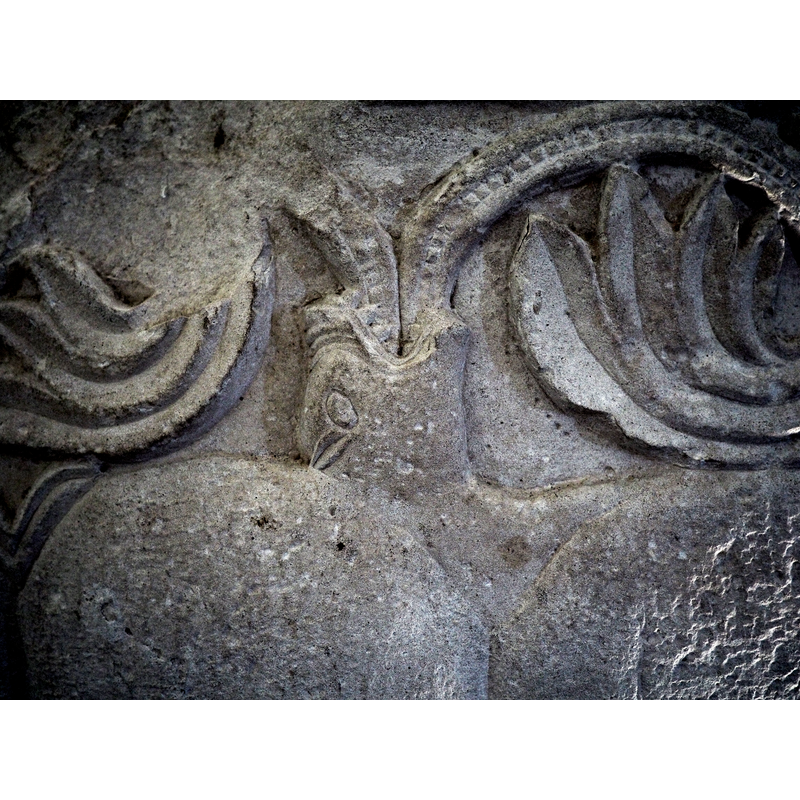
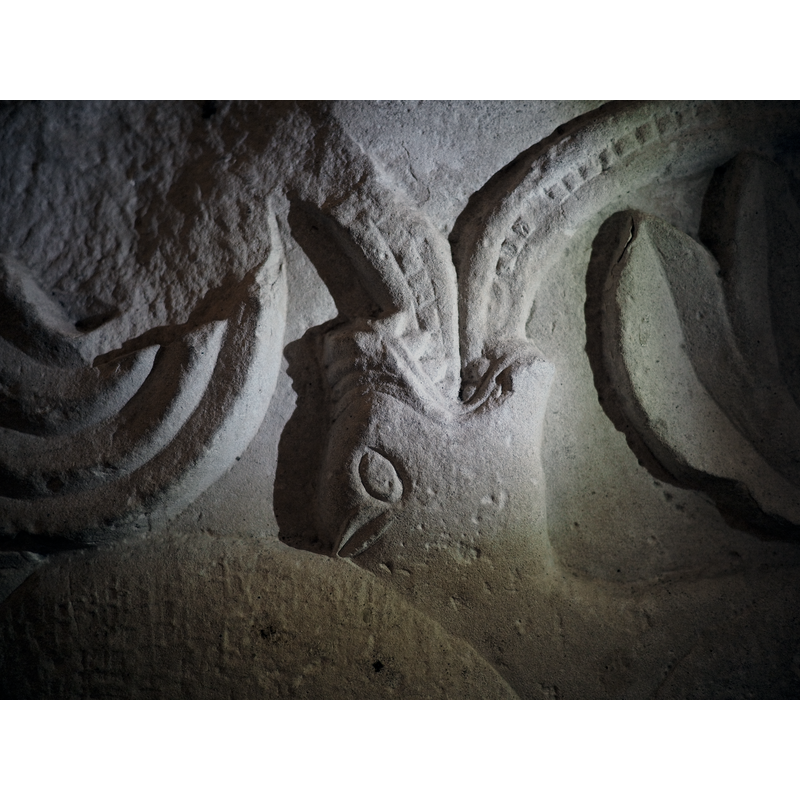
![the semi-hidden animal head has canine features and very prominent sharp teeth; two beaded tapes issue from between its jaws and form a stylised acanthus vine that wraps all around the upper side of the basin [NB: the detailed of the head is shown here rotated 90 degrees clockwise]](/static-50478a99ec6f36a15d6234548c59f63da52304e5/compressed/1161021046_compressed.png)
